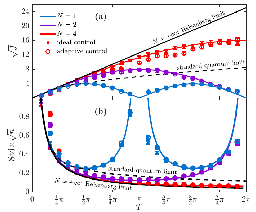USTC realized general quantum parameter estimation at the Heisenberg limit
CAS Key Laboratory of Quantum Information, USTC, led by academician GUO Guangcan, has achieved new progress in quantum metrology.The group of Prof. LIChuanfeng and Prof. XIANG Guoyongin the lab and their collaborator Prof. YUAN Haidong from Chinese University of Hongkong firstly realize control-enhanced sequential scheme for general quantum parameter estimation at the Heisenberg limit. The main results have been published in journal “Physical Review Letters” [Phys. Rev. Lett. 123, 040501 (2019)].
Precision measurements are a major driving force of science and technology. The state-of-art traditional metrology like LIGO interferometer has already reached its foundational ceiling, which is known as shot-noise limit. Fortunately, the next-generation quantum metrology can increase the ceiling of precision up to Heisenberg limit. In 2007, Geoff Pryde's group (Nature 450, 393--396 (2007)) used direct sequential measurement to demonstrate a scalable entanglement-free method to achieve Heisenberg-limit precision for optical phase estimation, where the dynamics are commuting. However, noncommuting dynamics are ubiquitous in practical applications of quantum metrology, such as in the estimation of orientations of objects, quantum gyroscope, quantum gate characterization, which can have distinct features from commuting dynamics. For example, the direct sequential scheme, which can achieve the Heisenberg scaling for the phase estimation under commuting dynamics, can have even worse performances than the classical scheme under noncommuting dynamics. A scalable scheme that can work under general noncommuting dynamics is in high demand for practical applications of quantum metrology.
By adding optimal quantum controls into the direct sequential scheme, XIANG Guoyong et al. experimentally realized, for the first time, a scalable control-enhanced sequential scheme that can reach the Heisenberg precision for general non-commuting dynamics. The optimal controls used in this scheme in general need to be updated adaptively, however, they also identify sweet time points at which the optimal controls can be pre-fixed without adaptation. This simplifies the experimental protocols significantly. They successfully implement the scheme up to eight controls in an optical platform, demonstrating a precision near the Heisenberg limit.Moreover, they found a nice intuitive geometrical picture to interpret the accumulation of overall signal strength as displacement integrated from velocity, which may help to understand the roles of quantum controls in the work.


Control-enhanced sequential scheme,geometrical picture and some experimental results
In contrast to previous experiments in quantum metrology which mostly deal with commuting dynamics, our control-enhanced sequential scheme paves the way for Heisenberg limited quantum metrology for general dynamics, it also opens the avenue for harvesting the powers of quantum control in quantum metrology.
The first author of this work is Research Associate HOU Zhibo from the lab and the corresponding authors are Prof. XIANG Guoyong and Prof. YUAN Haidong. This work is supported by theNational Key Research and Development Program of China, the National Natural Science Foundation of China (NSFC), the Key Research Program of Frontier Sciences, CAS, the Anhui Initiative in Quantum Information Technologies and the China Postdoctoral Science Foundation.
Article link:https://journals.aps.org/prl/abstract/10.1103/PhysRevLett.123.040501
Back
